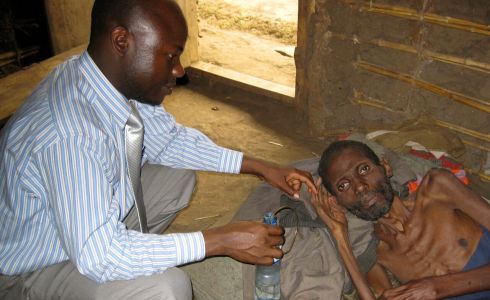 The Africa Situation and Why the Hospice Africa Uganda Model of Pain Relief can Help Millions
The Africa Situation and Why the Hospice Africa Uganda Model of Pain Relief can Help Millions
Africa is currently facing an AID and cancer epidemic.
HIV/AIDS
An estimated two-thirds of all reported cases of HIV/AIDS in the world are in Sub-Saharan Africa. Currently, 25.3 million[i] people on the African continent are living with HIV or AIDS, and will eventually die from it, claiming even more lives than malaria.[ii]
Cancer
Yet despite AIDS’ infamous reputation, it is cancer that claims the most lives in Africa. By 2020, an estimated 1 million people will die every year in Africa from cancer alone, accounting for 10% of the world’s cancer deaths.[iv] Yet, IPRI estimates that the cancer statistics are being underestimated. Further, the situation is compounded by the challenges Africa faces responding to this crisis.
AFRICA’S CHALLENGES
Lack of access to medical services and curative treatments
Currently, 30 out of 55 countries do not have a radiotherapy machine. Those that do, may use an outdated cobalt machine. It’s estimated only 5% of Africa’s population will ever reach such a center. Yet, those that make it will often have very advance cases of cancer. Only 5% that do reach such a center will benefit from the treatment. [viii] In some countries, the wait for radiotherapy is over two years and patients often die before receiving treatment.
In Uganda, despite great progress, 57% of Ugandans[ix] do not have access to a health worker. Uganda has 1 doctor for every 19,000 people, and they are concentrated in urban locales.[x] In rural villages, one doctor is available for 50,000 people.[xi] The country has one cancer center for its population of more than 30 million people. HAU estimates that 200,000 Ugandans are living in a state of daily pain and need palliative care.[xii] These statistics are much worse in other African countries that do not have an integrated palliative care system.
The video (4min) below briefly outlines the reality and challenges of Africa’s cancer epidemic.
AFRICA’S REALITY
Millions of people will get cancer and AIDS and die very painful deaths. Curative treatment is not currently an option. The monetary means needed to create the infrastructure will not manifest in time to help these people. However, affordable and accessable palliative care services can be a reality. The Hospice Africa Uganda model can help millions that would otherwise face unbearable pain, have pain relief and dignity in death.
Click here to learn more about how the vision of Hospice Africa and the role of the Foundation can help relieve the suffering for millions of people.
[i] Yale AIDS Watch. Africa: AIDS effect on Africa population. Retrieved on January 8, 2013, from http://www.yale.edu/yaw/africa.html.
[ii] Ibid.
[iii] amfAR: The Foundation for AIDS research, op cit.
[iv] Merriman, A. (2010).Audacity to love: the story of hospice Africa. Dublin: Irish Hospice Foundation, pp. 36.
[v]Mayo Clinic Staff. Cancer survival rate: What it means for your prognosis. Retrieved on January 9, 2013., from http://www.stjude.org/stjude/v/index.jsp?vgnextoid=5b25e64c5b470110VgnVCM1000001e0215acRCRD
[vi] For more information on the differences between curative and palliative trajectories, see, Merriman 2010, op cit, pp. 36-41.
[vii] Ibid, pp. 39.
[viii] Ibid.
[ix] Murray 2012, op cit.
[x] Ibid.
[xi] Ibid.
[xii] Ibid.
[xiii] Sepulveda C, Habiyambere V, Amandua J, Borok M, Kikule E, Mudanga B, et al.(2003). Quality care at the end of life in Africa. BMJ. 327(7408): pp. 209-13.